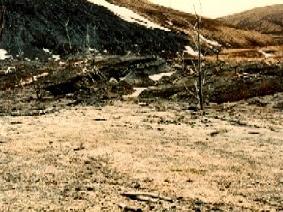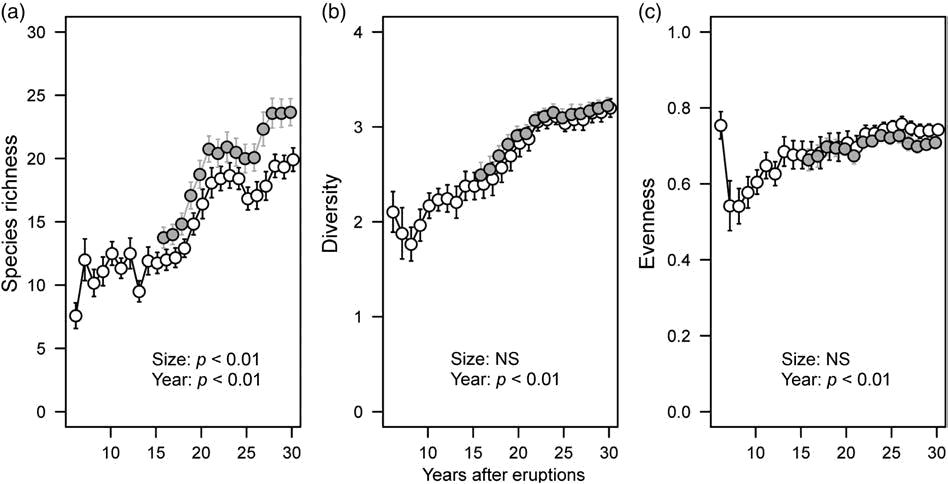(Upload on June 18 2021) [ 日本語 | English ]
Mount Usu / Sarobetsu post-mined peatland
From left: Crater basin in 1986 and 2006. Cottongrass / Daylily
HOME > Research summary > Volcanic succession > Scuccession on Mount Usu
[ volcanoes | volcanology | Mount Usu ]
Summit area before the 1977-78 eruptionsForests dominated by Populus maximowiczii and Betula platyphylla var. japonicaArtificial meadows: grazed by cow The effects of the 1977-78 eruptionsThe summit area was covered with volcanic ejecta of which thickness was 1-3 m→ the former vegetation was completely destroyed After the eruptions, I have annually monitored vegetation succession on the summit areas, by using permanent plots, since 1983. The survey in 2015 was completed. |
Group
I
II
III
IV
Total |
Permanent pltos monitored for more than 30 years confirmed the following four topics

Still increasing for 30 years Fig. Yearly fluctuations of mean (a) species richness, (b) diversity and (c) evenness for 25 years from 1984 to 2008 in 2 × 5 m plots (shaded circles) and from 1994 to 2008 in 5 × 5 m plots (open circles) after the 1977 and 1978 eruptions of Mount Usu, northern Japan. Mean (circles) is shown with standard deviation (vertical bars). The statistical significances were examined by generalized linear mixed model |
Litter decompositionChanges in the fungal and bacterial biomass and community structure in litter after the volcanic eruptions of Mount Usu, northern Japan, were investigated using a chronosequence approach, which is widely used for analyzing vegetation succession. The vegetation changed from bare ground (10 years after the eruptions) with little plant cover and poor soil to monotonic grassland dominated by Polygonum sachalinense with undeveloped soil (33 years) and then to deciduous broad-leaved forest dominated by Populus maximowiczii with diverse species composition and well-developed soil (100 years). At three chronosequential sites, we evaluated the compositions of phospholipid fatty acids (PLFAs), carbon (C) and nitrogen (N) contents and the isotope ratios of C (δ13C) and N (δ15N) in the litter of two dominant species, Polygonum sachalinense and Populus maximowiczii. The C/N ratio, δ13C and δ15N in the litter of these two species were higher in the forest than that in the bare ground and grassland. The PLFAs gradually increased from the bare ground to the forest, showing that microbial biomass increased with the development of the soil and/or vegetation. The fungi-to-bacteria ratio of PLFA was constant at 5.3 ± 1.4 in all three sites, suggesting that fungi were predominant. A canonical correspondence analysis suggested that the PLFA composition was related to the successional ages and the developing soil properties (P < 0.05, ANOSIM). The chrono-sequential analysis effectively detected the successional changes in both microbial and plant communities. |